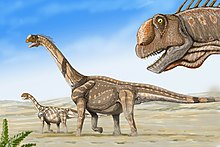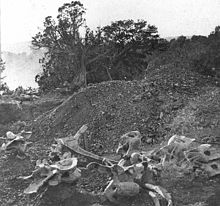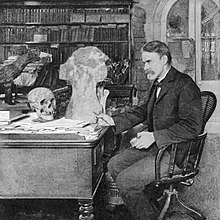
Apatosaurus is a genus of herbivorous sauropod dinosaur that lived in North America during the Late Jurassic period. Othniel Charles Marsh described and named the first-known species, A. ajax, in 1877, and a second species, A. louisae, was discovered and named by William H. Holland in 1916. Apatosaurus lived about 152 to 151 million years ago (mya), during the late Kimmeridgian to early Tithonian age, and are now known from fossils in the Morrison Formation of modern-day Colorado, Oklahoma, New Mexico, Wyoming, and Utah in the United States. Apatosaurus had an average length of 21–23 m (69–75 ft), and an average mass of 16.4–22.4 t. A few specimens indicate a maximum length of 11–30% greater than average and a mass of approximately 33 t.

Allosaurus is an extinct genus of large carnosaurian theropod dinosaur that lived 155 to 145 million years ago during the Late Jurassic period. The name "Allosaurus" means "different lizard", alluding to its unique concave vertebrae. It is derived from the Greek words ἄλλος and σαῦρος. The first fossil remains that could definitively be ascribed to this genus were described in 1877 by famed paleontologist Othniel Charles Marsh. As one of the first well-known theropod dinosaurs, it has long attracted attention outside of paleontological circles.

Camarasaurus was a genus of quadrupedal, herbivorous dinosaurs and is the most common North American sauropod fossil. Its fossil remains have been found in the Morrison Formation, dating to the Late Jurassic epoch, between 155 and 145 million years ago.

Barosaurus was a giant, long-tailed, long-necked, plant-eating sauropod dinosaur closely related to the more familiar Diplodocus. Remains have been found in the Morrison Formation from the Upper Jurassic Period of Utah and South Dakota. It is present in stratigraphic zones 2–5.
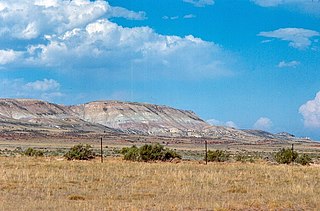
Como Bluff is a long ridge extending east–west, located between the towns of Rock River and Medicine Bow, Wyoming. The ridge is an anticline, formed as a result of compressional geological folding. Three geological formations, the Sundance, the Morrison, and the Cloverly Formations, containing fossil remains from the Late Jurassic of the Mesozoic Era are exposed.

Brontosaurus is a genus of herbivorous sauropod dinosaur that lived in present-day United States during the Late Jurassic period. It was described by American paleontologist Othniel Charles Marsh in 1879, the type species being dubbed B. excelsus, based on a partial skeleton lacking a skull found in Como Bluff, Wyoming. In subsequent years, two more species of Brontosaurus were named: B. parvus in 1902 and B. yahnahpin in 1994. Brontosaurus lived about 156 to 146 million years ago (mya) during the Kimmeridgian and Tithonian ages in the Morrison Formation of what is now Utah and Wyoming. For decades, the animal was thought to have been a taxonomic synonym of its close relative Apatosaurus, but a 2015 study by Emmanuel Tschopp and colleagues found it to be distinct. It has seen widespread representation in popular culture, being the archetypal "long-necked" dinosaur in general media.

Epanterias is a dubious genus of theropod dinosaur from the Kimmeridgian-Tithonian age Upper Jurassic upper Morrison Formation of Garden Park, Colorado. It was described by Edward Drinker Cope in 1878. The type species is Epanterias amplexus. This genus is based on what is now AMNH 5767, parts of three vertebrae, a coracoid, and a metatarsal. Although Cope thought it was a sauropod, it was later shown to be a theropod. Gregory S. Paul reassessed the material as pertaining to a large species of Allosaurus in 1988. Other authors have gone further and considered E. amplexus as simply a large individual of Allosaurus fragilis. In 2010, Gregory S. Paul and Kenneth Carpenter noted that the E. amplexus specimen comes from higher in the Morrison Formation than the type specimen of Allosaurus fragilis, and is therefore "probably a different taxon". They also considered its holotype specimen not diagnostic and classified it as a nomen dubium.

Camarasaurus lewisi is a species of sauropod dinosaur from the Upper Jurassic of the United States. It was named by James A. Jensen in 1988. C. lewisi was originally placed in its own genus, Cathetosaurus, but in 1996 it was reclassified as a species of Camarasaurus; most researchers since have considered it to be one of the four valid species of Camarasaurus. Two unpublished studies have since argued that the genus Cathetosaurus should be reinstated, whereas two other studies have argued that C. lewisi may be a junior synonym of another species of Camarasaurus.

Dystrophaeus is an extinct genus of sauropod dinosaur. Its type and only species is Dystrophaeus viaemalae, named by Edward Drinker Cope in 1877. Its fossils were found in the Tidwell Member of the Morrison Formation of Utah. Due to the fragmentary condition of its only known specimen, the affinities of Dystrophaeus are uncertain, although excavations carried out at the discovery site since 1989 have uncovered more of the original specimen and hold the potential for an improved understanding of the taxon.

Marshosaurus is a genus of medium-sized carnivorous theropod dinosaur, belonging to the Megalosauroidea, from the Late Jurassic Morrison Formation of Utah and possibly Colorado.
Lourinhasaurus was an herbivorous sauropod dinosaur genus dating from Late Jurassic strata of Estremadura, Portugal.

Camarasauridae is a family of sauropod dinosaurs. Among sauropods, camarasaurids are small to medium-sized, with relatively short necks. They are visually identifiable by a short skull with large nares, and broad, spatulate teeth filling a thick jaw. Based on cervical vertebrae and cervical rib biomechanics, camarasaurids most likely moved their necks in a vertical, rather than horizontal, sweeping motion, in contrast to most diplodocids.

Camarasaurus grandis is an extinct species of sauropod dinosaur in the genus that lived during the Jurassic in what is now the western United States. It is the geologically oldest of the four species of the genus Camarasaurus.
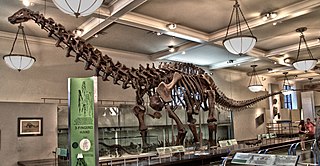
Apatosaurinae is a subfamily of diplodocid sauropods, an extinct group of large, quadrupedal dinosaurs, the other subfamily in Diplodocidae being Diplodocinae. Apatosaurines are distinguished by their more robust, stocky builds and shorter necks proportionally to the rest of their bodies. Several fairly complete specimens are known, giving a comprehensive view of apatosaurine anatomy.

Camarasaurus lentus is an extinct species of sauropod dinosaur that lived during the Jurassic period in what is now the western United States. It is one of the four valid species of the well-known genus Camarasaurus. C. lentus fossils have been found in Wyoming, Colorado, and Utah. It is the species of Camarasaurus found in Dinosaur National Monument and the middle layers of the Morrison Formation. Camarasaurus lentus is among the best-known sauropod species, with many specimens known. A juvenile specimen of C. lentus, CM 11338, is the most complete sauropod fossil ever discovered.
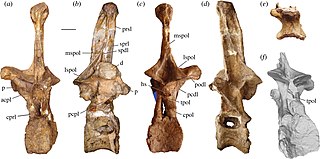
Amphicoelias is a genus of herbivorous sauropod dinosaur that lived approximately 150 million years ago during the Tithonian of what is now Colorado, United States. Amphicoelias was moderately sized at about 18 metres (59 ft) in length and 15 metric tons in body mass, shorter than its close relative Diplodocus. Its hindlimbs were very long and thin, and its forelimbs were proportionally longer than in relatives.

Diplodocus was a genus of diplodocid sauropod dinosaurs, whose fossils were first discovered in 1877 by S. W. Williston. The generic name, coined by Othniel Charles Marsh in 1878, is a Neo-Latin term derived from Greek διπλός (diplos) "double" and δοκός (dokos) "beam", in reference to the double-beamed chevron bones located in the underside of the tail, which were then considered unique.

Brachiosaurus is a genus of sauropod dinosaur that lived in North America during the Late Jurassic, about 154 to 150 million years ago. It was first described by American paleontologist Elmer S. Riggs in 1903 from fossils found in the Colorado River valley in western Colorado, United States. Riggs named the dinosaur Brachiosaurus altithorax; the generic name is Greek for "arm lizard", in reference to its proportionately long arms, and the specific name means "deep chest". Brachiosaurus is estimated to have been between 18 and 22 meters long; body mass estimates of the subadult holotype specimen range from 28.3 to 46.9 metric tons. It had a disproportionately long neck, small skull, and large overall size, all of which are typical for sauropods. Atypically, Brachiosaurus had longer forelimbs than hindlimbs, which resulted in a steeply inclined trunk, and a proportionally shorter tail.

Maraapunisaurus is a genus of sauropod dinosaur from the Late Jurassic Morrison Formation of western North America. Originally named Amphicoelias fragillimus, it has sometimes been estimated to be the largest dinosaur specimen ever discovered. Based on surviving descriptions of a single fossil bone, scientists have produced numerous size estimates over the years; the largest estimate M. fragillimus to have been the longest known animal at 58 metres (190 ft) in length with a mass of 150 tonnes. However, because the only fossil remains were lost at some point after being studied and described in the 1870s, evidence survived only in contemporary drawings and field notes.
